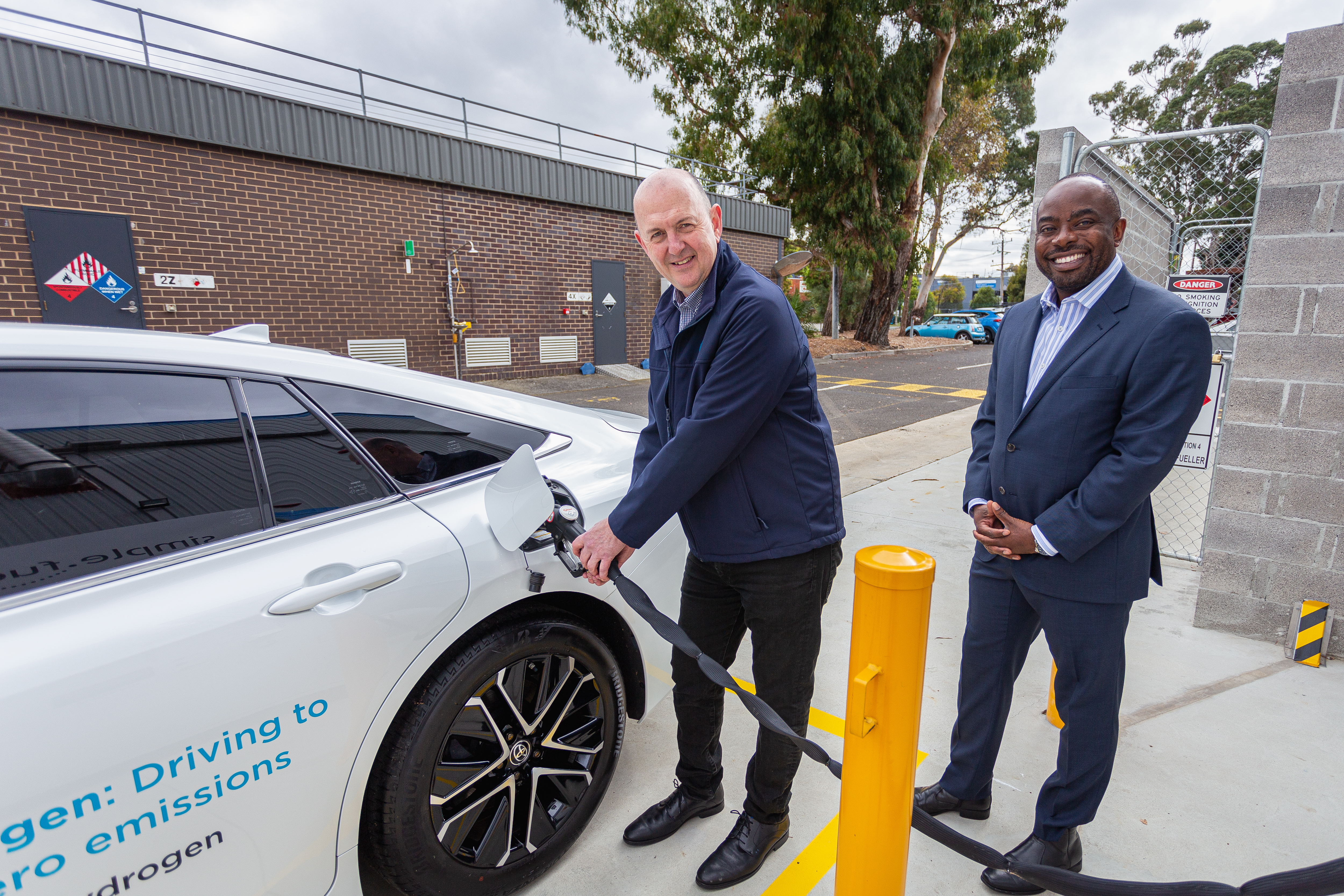Swinburne and CSIRO launch state-of-the-art renewable hydrogen refuelling station

Leader of CSIRO's Hydrogen Industry Mission Dr Patrick Hartley and Director of the Victorian Hydrogen Hub Gordon Chakaodza at the new hydrogen refuelling station.
In summary
- Swinburne and CSIRO have launched a state-of-the-art clean hydrogen refuelling station, purpose-built for enabling hydrogen research.
- The $2.5 million refuelling station uses green hydrogen produced with electricity from renewable sources.
- The station showcases the real-world application of hydrogen and will be used to demonstrate hydrogen’s utility for transport.
Swinburne University of Technology's Victorian Hydrogen Hub (VH2) and Australia’s national science agency, CSIRO have today launched a state-of-the-art clean hydrogen refuelling station, purpose-built for enabling hydrogen research.
The $2.5 million refuelling station uses green hydrogen produced with electricity from renewable sources that allows hydrogen cars to travel over 600km emissions-free on a full tank.
Located at CSIRO’s Clayton site in Victoria, the station showcases the real-world application of hydrogen and will be used to demonstrate hydrogen’s utility for transport.
It will also be used to test emerging hydrogen technology and train the next generation on the use of hydrogen stations to ensure Australia remains internationally competitive.
Professor Karen Hapgood, Deputy Vice-Chancellor Research, Swinburne University of Technology said the station, co-funded by VH2 and the Victorian Government’s Higher Education State Investment Fund, represented a unique opportunity.
"The launch of the hydrogen station brings Australia another step closer to creating a carbon neutral world by 2050 or earlier,” Professor Hapgood said.
“As a university with sustainability in our DNA, we are proud to be playing an important role in driving the implementation of the hydrogen economy in Australia, through our Victorian Hydrogen Hub and collaboration with CSIRO.
“Hydrogen plays a key part in our transition to clean energy, and demonstration projects such as these help to test technical, regulatory and economic aspects of hydrogen refuelling infrastructure, and support the urgent training and workforce development for this expanding hydrogen energy ecosystem.”
Minister for Skills and TAFE Gayle Tierney said, “Victoria’s renewable hydrogen sector will create long-term jobs and new career pathways, giving Victorians more opportunities to gain qualifications in an area where skills are in demand".
"That’s why we’re proud to support Swinburne’s VH2 project with $10 million in funding from the $350 million Victorian Higher Education State Investment Fund, which supports universities undertaking projects that will boost Victoria’s economy.”
CSIRO Chief Executive Dr Doug Hilton said hydrogen will play a significant role in Australia’s energy transition and the decarbonisation of our road transport sector.
“The technology is an exciting piece in the puzzle in Australia’s renewable energy future and will deliver long-term community and environmental benefits, boost the economy and create new jobs and opportunities for Australia and Australians,” Dr Hilton said.
“This is innovative, inventive, inspired technology that builds the sovereign capabilities Australia needs to transition to net zero.”
The refuelling station can generate up to 20kg of green hydrogen a day via electrolysis, and has a storage capacity of 80kg, enough for more than 10 cars.
The station is a significant component of CSIRO’s Hydrogen Industry Mission, which aims to support national and global decarbonisation through leading research and the development of a commercially viable
Australian hydrogen industry, comprising both domestic and export chains.
“Hydrogen is increasingly being recognised as ‘the fuel of the future’ – and for good reason,” Dr Hilton said.
“Hydrogen is the most abundant chemical element in the universe and, when used to power fuel cell electric vehicles the only exhaust product is water vapour.”
Victorian Hydrogen Hub Director, Mr Gordon Chakaodza said the collaboration with CSIRO was a key pillar in the hub’s mission to further Australia’s hydrogen economy.
“We are using state-of-the-art facilities to demonstrate to industry and the community the capabilities of fuel cell electric vehicles. This will cement Victoria as a key player in accelerating the deployment of hydrogen cars in Australia.” Mr Chakaodza said.
-
Media Enquiries
Related articles
-

- Student News
- Science
- Sustainability
Introducing tomorrow’s global science communicators
Start Talking is Swinburne’s unique video-based public speaking competition, exclusively for undergraduate students
Monday 08 December 2025 -

- Astronomy
- Technology
- Health
- Science
- University
- Sustainability
- Engineering
Swinburne highly cited researchers reach the top in 12 fields
Ten Swinburne academics have been named on the Highly Cited Researchers 2025 list, released by Clarivate
Tuesday 02 December 2025 -

- Science
- Engineering
Swinburne secures grant to advance next-generation metamaterials research
Swinburne physicist Dr Weibai Li has received a Discovery Early Career Researcher Award from the Australian Research Council
Tuesday 02 December 2025 -

- Technology
- Health
- Science
- University
$1.2m ARC funding to boost national X-ray spectroscopy capability through Swinburne and QUT partnership
Swinburne has secured $1.2 million in the latest Australian Research Council Linkage Infrastructure, Equipment and Facilities scheme round
Tuesday 02 December 2025 -

- Sustainability
Swinburne achieves carbon neutral certification
Swinburne has reached a major milestone in our sustainability journey - we are officially certified as carbon neutralThursday 20 November 2025

